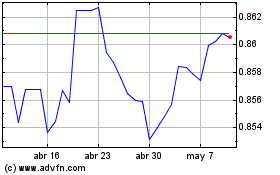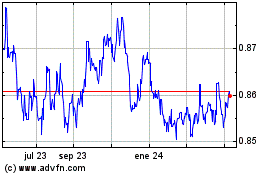Euro Rises Amid Risk Appetite
01 Marzo 2019 - 12:17AM
RTTF2
The euro strengthened against its major opponents in the
European session on Friday amid risk appetite, as
stronger-than-expected U.S GDP data released overnight coupled with
positive manufacturing data from China helped ease growth worries.
Sentiment was also bolstered after White House economic advisor
Larry Kudlow said the U.S. and China are making "fantastic"
progress in their trade negotiations.
Data from Eurostat showed that Eurozone inflation accelerated in
February, while core price growth eased, and the unemployment rate
held steady in January.
The flash harmonized inflation for February was 1.5 percent,
which was higher than January's 1.4 percent. The latest rate was in
line with economists' expectations.
Meanwhile, the core inflation rate that excludes energy, food,
alcohol and tobacco, slowed to 1 percent in February from 1.1
percent in January. Economists had expected the rate to remain
unchanged.
Separate data showed that the euro area unemployment data was
steady at 7.8 percent in January after December's figure was
revised down from 7.9 percent.
Economists had expected the rate to remain unchanged at
December's original 7.9 percent.
The latest jobless rate was the lowest rate recorded in the euro
area since October 2008, Eurostat said.
The currency traded mixed against its major counterparts in the
Asian session. While it rose against the franc and the yen, it held
steady against the greenback and the pound.
The euro advanced to 1.1371 against the franc, from a low of
1.1337 hit at 5:45 pm ET. The euro is seen finding resistance
around the 1.15 level.
The single currency appreciated to a 2-day high of 0.8589
against the pound, following a decline to 0.8571 at 3:45 am ET. If
the euro rises further, 0.87 is possibly seen as its next
resistance level.
Survey data from IHS Markit showed that British manufacturing
growth slowed to its weakest level in four months in February with
manufacturers hastening to implement measures to cushion the
adverse effects of Brexit.
The IHS Markit/CIPS Purchasing Managers' Index for manufacturing
fell to a four-month low of 52 from 52.6 in January, which was
revised down from 52.8. The reading was in line with economists'
expectations.
The euro strengthened to 127.26 against the yen, a level unseen
since December 21, 2018. Next key resistance for the euro is seen
around the 129.00 level.
The euro recovered to 1.1377 against the greenback, from a 3-day
low of 1.1353 touched at 3:30 am ET. The euro is poised to
challenge resistance around the 1.16 level.
Looking ahead, Canada GDP data for December, U.S. personal
income and spending data for the same month, ISM manufacturing
index for February and University of Michigan's final consumer
sentiment index for February are due in the New York session.
Euro vs Sterling (FX:EURGBP)
Gráfica de Divisa
De Abr 2024 a May 2024

Euro vs Sterling (FX:EURGBP)
Gráfica de Divisa
De May 2023 a May 2024
